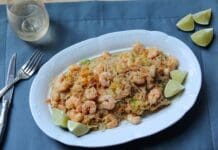By Melanie Stewart
As we continue on our digestive journey, we arrive at that blessed moment when we typically stop thinking about food for a while. With enough food in the stomach, we no longer feel hungry and our minds tend to move on without much thought beyond feeling satiated. But, this is where things really start to get interesting. As promised, here are a couple of simple food rules that may help enhance digestion and nutrient absorption:
Rule #1: “The thing about fruit that you might not have known,
It likes to be first and be eaten alone”.

The reason is fruit does not play well with others digestively. Though you may have learned otherwise, fruit is NOT a good side dish and it makes a terrible dessert. The reason has to do with digestive requirements. According to our programming, different foods need different amounts of time in the stomach before they move on. For example, proteins need up to 3 hours but most fruits need 30 minutes or less. When eaten alone, fruit will exit the stomach rather quickly and continue digesting in the small intestine where the nutrients are easily accessed. When eaten with or after other foods, fruit becomes trapped in your stomach. This is a problem because when fruits break down they release sugar. These sugars then feed the ever-present bacteria in your stomach, which can lead to digestive distress and the creation of unwanted toxins. As like most rules there are some exceptions: Combining fruit with specific healthy fats, in a smoothie for example, is allowed. Mainly you want to avoid eating fruit as a side dish or as a dessert.
Rule # 2: Dense protein with starch can taste good but, BEWARE!
They need different enzymes; they’re not a good pair!
Combining fruit, vegetable, starch, protein and fat, along with a big glass of milk, at ANY meal is a digestive nightmare! Yet many of us were taught that this is balanced for every meal. To enhance digestion and nutrient absorption, it is best to eat dense proteins like meat, fish or poultry and dense starches like rice, potato, pasta or bread, SEPARATELY and here’s why:
Proteins require an acid medium of digestive enzyme; Starches require an alkaline medium of digestive enzyme. As you may recall from chemistry class, when we combine acid and alkaline we get a neutral solution. Similarly, when we eat protein and starch in the same meal, both enzymes are released and the digestive solution is effectively neutralized. As a result, it is less efficient at breaking down your foods properly.
“No steak with potato? No chicken and rice?
It’s better with veggies or salad is nice!”
As an experiment, begin working with your perfectly designed system. Start planning meals that have any form of protein surrounded by a variety of non-starchy vegetables and/or a green leafy salad. Do not include any bread, potato, rice or pasta with your meal. Does this mean no meat sandwiches, no hamburger and fries? YES, that’s what it means. To improve health and expedite weight loss you are better off surrounding your protein with fresh vegetables and leaving the starch for another time. Starches ultimately break down into sugar so, if weight loss is a goal, I recommend limiting them and having them earlier in the day. Like protein, if you choose to eat a starch, pair it with a variety of non-starchy vegetables.
Melanie Stewart has written 2 books for children (Yum Tum, Good Food is Fun! and Yum Tum, We Get it Done!) and one for adults (Yum Tum For Everyone!) all available on Amazon. For more information, to book a seminar, or for private counseling, you can fill out the contact form at: https://www.yumtumnutrition.com/ or email: melanie@yumtumnutrition.com. All content is commentary or opinion and is protected under Free Speech laws. It’s not meant to give individual medical advice or to make any health claims on the prevention or curing of diseases.

























































